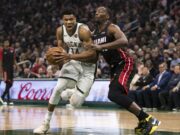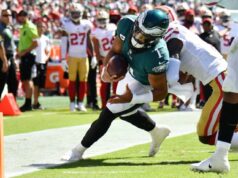A Cause for Concern
Up until Tuesday’s resigning of free agent backstop JT Realmuto, it had been a relatively quiet offseason for the Philadelphia Phillies. Coming off of a 28-32 record in a COVID-shortened 2020 season, the Phillies have largely opted for a less is more approach to retooling their roster for the 2021 season. Prior to the signing of Realmuto, the team’s biggest acquisitions were closer Archie Bradley and Jose Alvarado. Enough has already been said about the historical awfulness that was the Phillies bullpen in 2020; the additions of Bradley and Alvarado should go a long way in remedying this weakness. That being said, the Phillies desperately need to shore up the backend of their starting rotation in order to be competitive this upcoming season.
The Phillies currently feature one of the National League’s best 1-2 punches in Aaron Nola and Zack Wheeler and Zach Eflin has slowly grown into being a dependable #3 option. After that, things begin to get a little murky as last year’s trio of Jake Arrieta, Vince Velazquez, and Spencer Howard simply won’t cut it in the 4-5 holes of the starting rotation.
Honestly, the expiration of the Jake Arrieta contract is a bit of a blessing in disguise; the former Cy Young winner never justified the three year, $75 million contract he signed prior to the 2018 season, going 22-23 with a 4.36 ERA during his Phillies tenure. At this point, getting him off the roster is an addition by subtraction. Vince Velazquez is what he is at this point in his career; he’ll get you twice through the opposing team’s lineup before struggling thereafter. Spencer Howard, the Phillies #1 overall prospect, debuted in 2020 featured a fantastic fastball/slider combination that produced 23 Ks in just 24.1 innings, but he was snake bitten by the long ball (6 home runs allowed in those aforementioned 24.1 innings).
Because of the aforementioned pitchers’ struggles, the Phillies would benefit from adding a mid-rotation starter to the staff, preferably one with a track record of durability and consistency. Browsing the list of free agents, there’s one name that stands out as being worthy of a one-two year deal to eat up some innings with, at minimum, league average production. His name? Julio Teheran.
Where Did Things Go Wrong in 2020?

Now, I’ll admit: Teheran was atrocious in 2020. A member of the Atlanta Braves for nine seasons, Teheran stumbled through his one-year stint with the Los Angeles Angels this past season, seeing his season derailed by a COVID diagnosis on July 19th. The durable righty simply never got on track, compiling a 0-4 record with a 10.05 ERA. That being said, there should be some room for optimism that Teheran can return to his normal productive self in 2021.
One of the things that I look at when evaluating a pitcher’s ability to succeed is their “stuff”. If they are hard throwers, do they consistently ramp up to 93-95 MPH? If they are off-speed experts, what are the spin rates on their breaking balls and change-ups? Where do they spot their pitches? What does their pitch mix look like? Teheran once regularly pumped 92-94 MPH on his four-seam fastball, but he’s fundamentally changed as a pitcher since his early-20s. He features a five pitch arsenal and mixes-and-matches all five of his offerings to righties and lefties alike. He’s always been durable; throughout his nine year MLB career, he’s only spent forty-six days on the DL, fourteen of which were related to his COVID diagnosis in 2020. There’s a lot to like when we look at the track record of the product out of Cartagena, Colombia.
In 2019, Teheran notched a 3.81 ERA while notching one of the highest K/9 rates of his career and one of his lowest HR/9 rates of his career. Long story short, Teheran was missing bats, keeping the ball in the park, and was putting his team in a position to win each time he took the mound. Yet, in 2020, despite featuring virtually the same mix of pitches, Teheran struggled to get anybody out. What gives? Upon closer inspection, what I saw was a pitcher who struggled to consistently hit his spots, particularly with his sinking fastball. Check out the video below of Teheran in 2019:
We see Teheran do an excellent job running his sinker in to his arm side. The pitch has great lateral movement in on righties/away from lefties. This movement is particularly important for a guy who doesn’t throw hard. An 89 MPH fastball is just as effective as one at 96 MPH if they’re both in on the hands. Over the plate? Not so much. By running his fastball in on opponent’s hands, Teheran opens up the lower half on the outside portion of the plate for his curveball and slider (you can see him induce a swinging K on his slider later in the video).
So, what happened in 2020? Well, Teheran struggled to run his fastball down and in to his arm side. More often than not, his 4-seamer and sinker tunneled down the middle of the plate. Look at this egg he laid down the heart of the plate against Anderson Tejada of the Texas Rangers:
Anderson Tejada goes big fly off of Julio Teheran for a solo HR #Rangers 3 #Angels 0 pic.twitter.com/urGkmCoITe
— Sports ②④x⑦ (@B_R_R_D) September 20, 2020
Like I said earlier, at 89 MPH, you just can’t do that. Major league hitters will punish you at those speeds and punish him they did. In 2019, hitters logged a .232 batting average against his fastball. In 2020? .379. It was essentially the same pitch in speed and break. His location was what ultimately did him in. If he gets back to locating his fastball, good results will follow.
Does Teheran Fit Into the Phillies Rotation?
Judging from some recent chatter on the hot stove, it seems like the Phillies carry similar hopes as I do that Julio Teheran will bounce back in 2021:
The @Phillies are scouting Anibal Sanchez and Julio Teheran. Let’s hope one of them come into the starting rotation.#Philly #Phila #Philadelphia #Phillies #Baseball #MLB #USA #CitizensBank
— Pro Scout Elite, Inc. (@ProScoutEliteI1) January 20, 2021
Should the Phillies sign him, he’d be a major upgrade to the back end of their rotation. The Phillies need length and, at minimum, league average performance out of the back end of their starting rotation. If Teheran regains his 2019 form, he should put up his usual numbers: 170-190 innings with a 3.20-3.80 ERA. Should he do that, don’t be surprised if he logs 12-14 wins with this offense backing him up. Eating up innings, minimizing exposure of the bullpen, putting his team in a position to win. What more could you ask for?




























